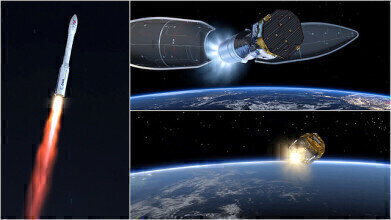News & Views
How to Measure Ripples in Space Time
Dec 19 2015
Space scientists are continually striving to achieve new feats, and The European Space Agency (ESA) is the latest entity to make history. Earlier this month, the ESA launched a rocket loaded with two cubes made of platinum and gold. At a cost of over US$450 million, the LISA Pathfinder goal is to find out how the cubes react to being in freefall almost a million miles from Earth.
Foundations for the future
While it sounds like a somewhat irrational enterprise, the project is actually paving the way for a second, more ambitious mission. During this project, space scientists will attempt to shield the cubes from external influences. By creating a practically perfect cosmic isolation chamber, the scientists will be able to accurately measure the infinitesimal effects of gravitational waves.
According to Oliver Jennrich, one of the projects space scientists, "Our biggest enemy is the light from the sun that hits the satellite and pushes it around."
To counter the influential rays, the satellite will be equipped with thrusters that are able to make miniscule correction to the probe’s position. This will ensure that it remains in the correct orbit pattern, and doesn’t cause the cubes to move around inside the box.
When the results are in, the ESA plans to kick-start a project that will see scientists attempt to measure ripples in space time. These are caused by massive objects that lurk throughout the galaxy, including black holes.
"We want to see whether we can create an environment in orbit that's free of interference, and where we can conduct these high-precision measurements," explains Michael Menking. As senior vice-president for Earth observation, navigation and science at Airbus Defence and Space, Menking knows his stuff.
Building on Einstein’s groundwork
It’s a next generation project, however it’s not necessarily an entirely new concept. One century ago, Albert Einstein predicted the existence of gravitational waves, but was never able to prove his theory. If all goes to plan, the second stage of the project will be ready to launch in 2034.
"It's probably the most challenging mission we're doing in the science program, because the precision by which you need to measure the test mass position is very, very high," said Arvind Parmar, head of the European Space Agency's scientific support office.
Gravity is an unstoppable force, however in the 1920s scientists discovered that ultracentrifuges have the ability to generate forces that are millions of times stronger than the natural phenomenon. ‘Technical Considerations for Ultracentrifugation’ looks at how the development devices has permitted the fractionation of subcellular components which were previously visible only through the use of an electron microscope. Now, scientists can use modern ultracentrifugation to determine the shape, size and weight of macromolecular complexes.
Image via Flickr Creative Commons. Credits: European Space Agency ?
Digital Edition
LMUK 49.7 Nov 2024
November 2024
News - Research & Events News - News & Views Articles - They’re burning the labs... Spotlight Features - Incubators, Freezers & Cooling Equipment - Pumps, Valves & Liquid Hand...
View all digital editions
Events
Nov 18 2024 Shanghai, China
Nov 20 2024 Karachi, Pakistan
Nov 27 2024 Istanbul, Turkey
Jan 22 2025 Tokyo, Japan
Jan 22 2025 Birmingham, UK




.jpg)














